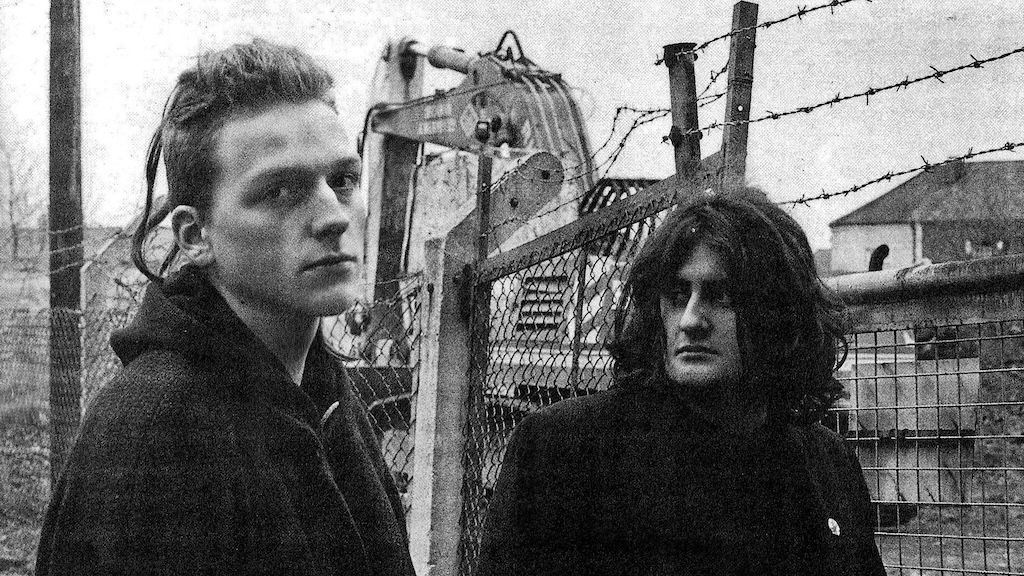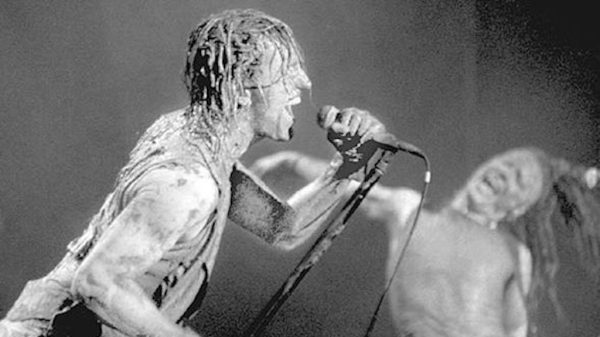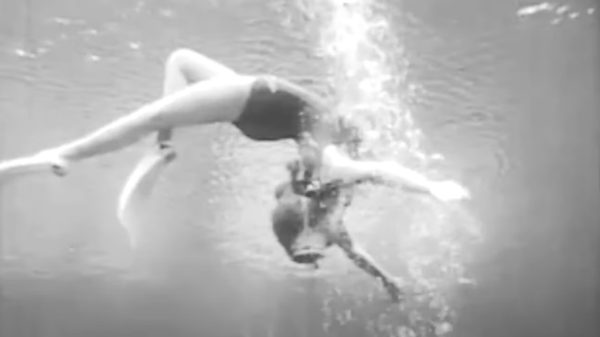Not long ago, I wrote an article about grindcore in the 90s from my recollections of the decade and the genre. When the idea came about, we also discussed doing the same for industrial in the same decade. I am attempting that here although the task will be more challenging.
It has nothing to do with a lack of love for the genre. As a metal musician, I consider it one of my biggest influences, but unlike grindcore, I never participated in a “scene”. I was just an enthusiastic outsider. This is largely because I was unaware of any kind of industrial scene in Indiana. Maybe I should’ve looked harder. So my perspective here will be unique, and probably not representative of the average industrial fan, but the music, books, and films I discuss mean a hell of a lot to me.
So let’s start at the beginning. In 1990, I was a burgeoning metal head, splitting my time between Bay Area thrash and hair metal bands, and along with this came a newfound appreciation for horror movies. In the theaters was a little-known flick called Hardware, and I don’t know how we knew about it, but my friend Bill and I went to the mall to go see it. I am sure one of our parents dropped it off. We bought a ticket to see My Blue Heaven, starring Steve Martin and Rick Moranis, because we weren’t old enough to buy R-rated tickets yet. We, of course, planned to slip into see Hardware instead, but something went wrong and we ended up watching My Blue Heaven instead.
Undaunted, we returned a week later, now with our friend Phil in tow and we managed to sneak into Hardware. It’s a pretty dope movie with cameos by Lemmy and Iggy Pop, and though I didn’t know it at the time, it really gave off an industrial vibe. More importantly, there is a scene midway through the movie where the female lead, played by Stacey Travis, is flipping stations on a TV and happens upon a video of Gwar engaging in some sort of mayhem while Ministry’s “Stigmata” plays. Consider my mind blown.
The song snippet was repetitive and harsh and was certainly the first thing I ever heard that was heavy but not metal. I must’ve watched the credits closely because I soon found myself buying Ministry’s Land of Rape and Honey on cassette. Like many of my favorite albums, I didn’t understand it at first. The guitars were kind of heavy but not as much the focus compared to a regular metal record, the drums were obviously electronic, there were keyboards, and so on. What I did know is Al Jourgensen’s vocals were the most vicious thing I’d ever heard and that this music had an extremely dark and somewhat abstract quality. I listened to it over and over until I got it, even if I couldn’t articulate it.
I bought The Mind is a Terrible Thing to Taste soon after, and was even more addicted to the group than before. I could go on and on about that record but it did come out in 1989, so let’s skip ahead to 1992’s Psalm 69. I bought this the day it came out, back when record stores opened up at midnight to sell new releases. I bought Danzig III: How the Gods Kill the same night. The metal that had been present on Ministry’s previous releases truly blossomed on this record. While they would head even further into metal with subsequent releases, Psalm 69 represented a better balance for me. Honestly, this was the last record of theirs to do much for me, although most people I know with an opinion love Filth Pig.
Is it weird to call Ministry a gateway drug? If there guitar-laden industrial opened my mind to new possibilities, Godflesh’s Streetcleaner left that same mind completely obliterated. Justin Broadrick laid down nihilistic waves of guitar squall over crushing mechanized beats. Often overlooked, G.C. Green’s bass lines tied everything together with ruthless efficiency. As a bass player, his lines were a huge influence on my own approach to the instrument. Streetcleaner is one of the most important records in my life, and easily one of the bleakest.
Once again, I am cheating. Streetcleaner came out in’89, but I am pretty sure I didn’t get it until 1990. Yet everything they did throughout the ‘90s was absolutely vital. Pure, Slavestate, Selfless and so many more releases were all classics. I am aware that so far there’s been a lot of guitar in what I have mentioned and there will be a lot industrial metal in this article, but I promise it won’t be the sole focus.
I feel I am pretty picky when it comes to guitar in industrial music, but I bring it up now because Justin Broadrick does it better than anyone. His playing is stunningly original and abstract, heavy but often unpredictable. Selfless in particular is a masterpiece of strange and beautiful guitar work. Highlights include “Body Dome Light” and the almost 24-minute “Go Spread Your Wings.”
Slavestate, on the other hand, illustrates that Broadrick and Green equally understood the rhythmic possibilities of the genre. While the guitar isn’t absent here, the beats, bass, and synths are more prominent.
Now let’s turn to one of those guitar-less albums. Skinny Puppy released Too Dark Park in 1990 and I hesitated to buy it. I knew that it was industrial but I didn’t know much else. I had my Ministry, Godflesh, and Nine Inch Nails at this point but it was a leap for me to get a purely electronic album. Much like my first encounter with Ministry, I was at first confused and soon addicted. My metalhead brain struggled to understand how something “not heavy” in the way I understood at the time could be so dark. Oghr’s vocals were so menacing and his stream-of-consciousness lyrics added so much to the atmosphere. The music was amazing, immersive, and liminal, an altered state of consciousness expressed in sound. Out of the thousands of albums I’ve heard in my life, Too Dark Park and Streetcleaner are in the top 3 of all-time favorites.
Over the next couple of years, I dove deeper into Skinny Puppy, with Rabies, VIVI SECT VI, Last Rights, Cleanse, Fold, and Manipulate all being classics in my book. “Tin Omen” from Rabies was one of their only early tracks to have a metal guitar riff, and it foreshadows what can go wrong with metal guitar in this context. This song works for me anyway, but when they embraced guitar on 1996’s The Process, it made me lose interest in the band. The riffs were not good, but generic. It sounded like an outsider’s idea of what metal is supposed to sound like.
Embracing both sides of the guitar debate was Mick Harris’s Scorn. Originally formed with Napalm Death bandmate Nik Bullen, Scorn’s debut Vae Solis is one of the heaviest and nastiest industrial metal records of all time. It also featured Justin Broadrick on guitar although he doesn’t seem to have ever been an official member. The whole record sounds like drowning in a sewer of undifferentiated, raw meat. Truly sick stuff.
After Vae Solis, they switched gears with their follow-up, Colossus. Here, a more pronounced dub influence comes to the fore. The beats are insanely heavy but the metal elements are gone. Instead, the listener becomes lost in a timeless and weightless sonic environment. It is eerie as hell. Scorn continued to metamorphosis, especially after Bullen’s departure. Harris transformed the entity into a minimalist beat monster, consisting mostly of tectonic beats and bass drones, somehow amazing and consistent over an insane number of releases.
Next up, I have to address the incredible album The Anatomy of Addiction by Kevin Martin. God put out a slew of great records in the ‘90s but 1994’s The Anatomy of Addiction is the pinnacle of this kind of stuff. It’s like a big band version of Godflesh. This record features two saxophone players, including Martin himself along with Tim Hodgkinson of avant-garde prog rockers Henry Cow. There were also two guitars (one being the ubiquitous Justin Broadrick), a viola, an upright bassist, two bass guitars, a drummer, a percussionist, and a bass clarinetist. If such a large ensemble sounds like it would be a mess in an industrial metal context, it’s not. The Anatomy of Addiction is a lean and dangerous predator of an album, a creature with a thousand-yard stare. I honestly draw a throughline from this record to the movie Apocalypse Now’s final third, sounding like an assassin experiencing a mental breakdown.
Touching on a couple more industrial metal releases, let’s mention Nailbomb. The brainchild of Sepultura’s Max Cavalera and Fudge Tunnel’s Alex Newport, their one record mixes metal, punk, and industrial in equal measure. It’s a bit more straightforward than most of these other albums, but it’s so good, like some kind of primal scream therapy. What they lacked in the abstraction of the previously mentioned albums, they made up for in damn catchy tunes.
Pitchshifter was also an important band in this movement, at least their early records. 1991’s Industrial and their 1992 EP Submit were bonafide classics, even if they were a little too heavily indebted to Godflesh. They may not have invented the sound but they were damn good at playing it.
In 1993, they released their second full-length Desensitized. Here they started to move out from under Godflesh’s shadow. The vocals, while not as harsh, sound like proclamations from Big Brother himself while the music remained suitably crushing. After this record, they seemed to be influenced by the burgeoning industrial rock sounds of Nine Inch Nails and their spawn. Many thought that Desensitized is where things started to go wrong, but I think it’s their best record and their most original.
Two more really quick industrial metal albums worth mentioning are Treponem Pal’s Aggravation and Meathook Seed’s Embedded. Treponem Pal captures that nasty and abstract industrial sound while the guitar work avoids being generic. Napalm Death’s Mitch Harris and Obituary’s Donald Tardy and Trevor Peres originally created this monstrosity and lends further evidence that the Napalm boys were really in tune with the industrial music of the time.
There were a ton of groups in this era that gave industrial metal a bad name, often trying to ride the Nine Inch Nails bandwagon, but I think the above records transcended such mediocrity. And don’t get me wrong, I love those early NIN records, but they spawned many inferior imitators.
Getting back to the more electronic-based groups, my other favorites outside of Skinny Puppy deserve mentioning. Frontline Assembly’s Caustic Grip and Tactical Neural Implant mined a slightly less spooky and more aggressive version of Skinny Puppy’s sound and certainly were great records. They went the guitar route for a while starting with 1994’s Millenium which turned me off immediately. I relistened to it recently and it was much better than I remembered but I still prefer them before they explored metal.
Doubting Thomas was a Skinny Puppy side-project featuring two-thirds of that group, cEvin Key and Dwayne Goettel. It comes across as an instrumental version of their main group but certainly makes the case that their contribution deserves equal credit alongside Ohgr’s powerful vocals.
The duo then morphed into the entity known as Download. Essentially this consisted of the pair alongside any number of collaborators. Their debut Furnace brought in Mark Spybey of Dead Voices on Air and Zoviet France and Genesis P. Orridge of Throbbing Gristle and Psychic TV on vocals and was an absolute monster of a release. They took Skinny Puppy’s blueprint and exploded it to include any number of techno and experimental influences. Pretty much everything they’ve done has been amazing.
While it is questionable if it qualifies as “industrial,” I also have to mention Kevin Martin and Justin Broadrick’s Techno-Animal project. 1995’s Re-Entry married industrial and dub music into an insanely heavy and hypnotic double album. This record pushes the two-hour mark but it absolutely broke my head open when released. Headphones recommended. Don’t skip out on 2001’s Brotherhood of the Bomb either, another alchemical marriage of industrial and hip-hop that is essential. Both of these were recently reissued by Relapse Records.
Also, industrial gave birth to the bastard child of power electronics and harsh noise. I went down that rabbit hole as well. I remember getting Merzbow’s Venreology in the mail and thinking “What the fuck?” I quickly realized that such sounds created an altered state of consciousness when played at high volume. Such states might have been an important preoccupation at that time of my life.
I snatched up other Merzbow releases as well. Pulse Demon, Music for a Bondage Performance, and Eco-Bondage were all essential releases for me. But the two most important power electronic releases for me in those early days ended up being Masonna’s Inner Mind Mystique and the Japanese-American Noise Treaty comp. The former amplified the brutality of noise by including the manipulated human voice. It sounded more disconcerting than alien. The latter compilation gave an overview of all the major players of the scene at the time, and at two-cd’s in length, felt like an exercise in glorious masochism.
Musically, I feel like I’ve laid out some incredible records worth your time. But to me, industrial culture was not confined to just music. I want to also mention some films and literature as well.
Film-wise, there are some obvious correlations. I’m thinking of Bladerunner and the aforementioned Hardware. Also important were David Cronenberg’s Videodrome and Scanners. Videodrome in particular seemed to capture industrial culture’s aesthetic.
More underground films played a role as well. Tetsuo: The Iron Man was a fucked up Japanese film about a guy trying to stick scrap metal into his body. It’s not for the faint of heart. I also remember seeing some performance art videos from that period. One in particular sticks in my mind. A man has several deep slashes cut into his back, and then someone presses blank sheets of paper on the wounds and hangs them up to dry. I cannot figure out what it was called but I always associated that with “industrial”, but I may have been the only one. My second band ever, who tried to combine Neurosis and Godflesh, used this as a film playing behind our performance.

Literature also played an important role in my experience of industrial. Perhaps the most interesting example is IndustrialNation magazine. I owned most if not quite all of the print run and it was the most well-circulated periodical covering this scene. Ironically, between being a broke kid and the fact that the records were hard to find, I read about so many groups that I never got to listen to. As a musician, I feel like I was so influenced by what I imagined this music would sound like versus what it may have actually sounded like. Weird, right?

Also of great importance was the publisher Re/Search books. They published the Industrial Culture Handbook which originally came out in 1983 but seemed to rise to prominence in the ‘90s. It included interviews with Throbbing Gristle, SPK, and Survival Research Laboratories, and the things they discussed barely made sense to my relatively young mind. They also published books like Modern Primitives, The Torture Garden, and a book on J.G. Ballard that were equally mind-expanding.
Perhaps even more importantly, industrial culture led me to authors such as William S. Burroughs, Brion Gysin, and Kathy Acker. Burrough’s trilogy of Cities of the Red Night, The Place of Dead Roads, and The Western Land are three of the most incredible books I’ve ever read. Drugs, sex, pirates, and strangeness abound. I’m sure I heard about many of these from both Re/Search books and IndustrialNation.
Reading over this, I’m not sure if the writing on this article is as good as the grindcore article was but I implore you to seek this music (and books and films) out because it’s amazing stuff. After the ‘90s ended, I feel a lot of this music went deeper underground but in the past ten years or so there’s been a resurgence. It feels like I’m not the only one who was profoundly impacted by this stuff. So check out the newer bands coming out now: Statiqbloom, High Functioning-Flesh, Primitive Knot, Cromlech, Andrew Nolan, Dome Runner, and Jaw Surgery to name just a few. And with the internet, many of the other groups from the ‘90s are easier to find than they were back then. I now know the brilliance of Nitzer Ebb, Einstürzende Neubauten, Severed Heads, 23 Skidoo, Coil, and many more. So once again, I implore you to dig into this stuff, it is brilliant whether I articulate well or not.














